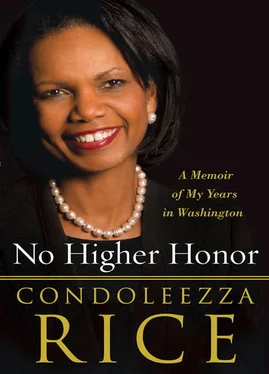The other major issue was what we’d say about timetables for eventual withdrawal. Maliki was facing nationalist pressures and needed, for political reasons, to be able to say that all U.S. forces would be gone by a specific deadline: the end of 2011. The Iraqis had already been taking on more responsibility for security and would assume full control over Al Anbar province on September 1. But we’d hoped to avoid setting a firm date for departure in order to allow conditions on the ground to dictate our decisions. Some also expressed concern that a firm date might give an impression of being driven out of the country. There were many arduous negotiating sessions between their team and ours, which was led by Brett McGurk, the senior director for Iraq and Afghanistan at the National Security Council. But we couldn’t come to an agreement.
When I went to see Maliki in August, I left thinking our team had nailed down the final details of the language. If the security situation remained stable, the United States was prepared to remove all U.S. combat troops by the end of 2011 but leave a contingent force of as many as 40,000 soldiers to assist the Iraqis with training and logistics. However, when I got back to Washington, he reneged, calling for the withdrawal of all U.S. forces by the end of 2011.
The process of negotiating the agreement was arduous. Every time the consensus failed inside the Iraqi political system, Maliki asked for more concessions. The President swallowed hard but pushed forward; he, more than anyone else, saw the strategic significance of the agreement.
Eventually we found suitable language, and Maliki, against pretty tough odds, was able to pass both the SOFA and the strategic framework agreement through his parliament. We’d given quite a lot of ground on issues such as a withdrawal timetable, consenting to the removal of all U.S. forces by the end of 2011, and we even conceded a limited level of Iraqi legal jurisdiction over our troops in cases of certain “grave premeditated felonies” when such crimes occurred off-duty and off-base. Ultimately, the compromises we made proved beneficial because the resulting SOFA put the end of the war in sight and left the new U.S. President a firm foundation for a successful conclusion of our presence there.
That late-summer trip was my last to Iraq, and it was very emotional. For the first time, the security situation permitted me to travel into the Red Zone, the region outside the fortified Green Zone, to visit some of the Iraqi leaders who lived there. A year before, that would have been impossible; we’d only been able to get to this point because of the extraordinary efforts of General David Petraeus, then commander of Multi-National Forces-Iraq, and Ambassador Ryan Crocker, one of our nation’s finest Foreign Service officers. I would later bestow the Secretary’s Distinguished Service Award, the highest honor I could give, on both members of this highly effective civil-military team.
As we turned the corner onto the main street in Baghdad’s Red Zone, I spotted a little boy standing in a field where kids were playing soccer. That would have been impossible a year before as well. The child, maybe eight years old, put his hand to his head in a salute. He’d apparently gotten used to seeing U.S. military convoys and thought we were one of them. He seemed quite unafraid of his surroundings or us. I raised my hand and returned his salute—even though by then we’d already passed him.
BEFORE THE Russian invasion of Georgia, I’d given serious consideration to resigning my post in September. I would lead the official U.S. delegation at the closing ceremonies of the Beijing Olympics, and that would be it. What a way to go out! I was really tired, and I also thought that it would be perfect to have my deputy, John Negroponte, become secretary of state for the remainder of the term. There had been few Foreign Service careers as distinguished as John’s; it would have been a fitting coda to his service. When I told Steve of the idea, he laughed. “The President will never go for it,” he said.
“Well, I’m going to try,” I said. But there never seemed to be a good time to bring up the idea, and once the Georgian war began, I knew I couldn’t leave.
Moreover, there were still a few loose ends, to put it mildly. I was especially concerned about completing the international components of the civil-nuclear deal with India. The historic accord announced by President Bush and Prime Minister Singh in July 2005 had actually been only the beginning. The U.S.-India deal took more than three years to finalize and demonstrates perfectly how difficult it can be to achieve a major foreign policy shift even if the heads of state of both countries are fully supportive and engaged. After the deal was announced in the summer of 2005, it had to go through several complex stages, including amendment of U.S. domestic law (the Atomic Energy Act of 1954) to permit civilian nuclear trade with India; negotiation of a bilateral “Section 123 Agreement” between the United States and India, which detailed India’s obligations and rights under the deal; an India-IAEA safeguards (or inspections) agreement; and the grant of an exemption for India by the Nuclear Suppliers Group, an export-control group of then forty-five countries. Finally, the U.S. Congress had to vote again to approve the “Section 123 Agreement.”
Each step was fraught with difficulty. Under secretary for political affairs Nick Burns served as my chief negotiator for the deal along with India expert Ashley Tellis. The pair moved mountains to negotiate the first detailed outline of the deal in early 2006. I personally testified before both houses of Congress in April of that year, and Nick, with his aide Anja Manuel, spent many hours explaining to skeptical senators and representatives why amending U.S. law to permit civilian nuclear trade with India made sense. The deal’s environmental friendliness was an advantage. One of the arguments that ended up having traction with Democrats in particular was that the deal would enable the United States—and American companies—to help India develop an emissionsfree energy source, and thus to rely less on its highly polluting domestic coal to generate electricity. In July and November of 2006 the House and then the Senate voted overwhelmingly, in bipartisan fashion, to amend U.S. law. Meanwhile, Anja and other State Department officials traveled to India a half-dozen times to hammer out the details of the “123 Agreement,” the implementing document, which was finally concluded on August 3, 2007.
But the marathon continued. Prime Minister Singh had to face down critics of the deal within India and would barely survive a no-confidence vote that almost brought down his unruly coalition government. After India finalized its own agreement with the IAEA, we needed the endorsement of the IAEA’s board of governors, a step that was achieved relatively easily in August 2008 after India agreed to give IAEA inspectors wider access to its civil nuclear facilities. Securing the consent of the Nuclear Suppliers Group was much harder.
The major nuclear technology suppliers—Russia, China, France, the United Kingdom, and, of course, the United States—all backed the deal. But there was significant resistance from the Austrians, the Irish, and the Nordic countries, all of which considered themselves guardians of the non-proliferation regime. John Rood, one of our primary negotiators and the acting under secretary for arms control and international security, was having little success in bringing these countries on board. Jonas Gahr Støre, the Norwegian foreign minister, tried to help, writing language that I approved to bring the recalcitrant states along. I was in Algiers during the negotiations and stayed up all night making phone calls. (They were in addition to the more than twenty that I’d made before leaving Washington.) Finally it came down to the Austrian foreign minister, Ursula Plassnik, who was at a European Council meeting in Brussels. I asked German Foreign Minister Frank-Walter Steinmeier to track her down and get her agreement. She apparently didn’t want to be found. But Frank-Walter persisted, and she instructed her negotiator to agree. John called the next morning to say that he had secured international consent from the Nuclear Suppliers Group to move ahead with the deal.
Читать дальше












